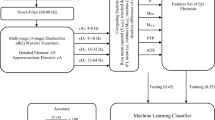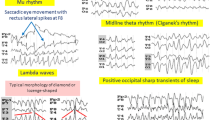Abstract
Recurrence quantification analysis is used to detect the P300 event-related potential in a single-trial EEG. It is shown that as a reaction to stimuli, the P300 component is associated with an increase in the complexity of the brain’s electrical activity. It is also shown that recurrence quantification analysis measures are sensitive enough to detect these changes even in single short time series.




Similar content being viewed by others
REFERENCES
Rugg, M.D. and Curran, T., Trends Cognit. Sci., 2007, vol. 11, no. 6, p. 251.
Luck, S.J. and Kappenman, E.S., The Oxford: Handbook of Event-Related Potential Components, Oxford: Oxford Univ. Press, 2011.
Herrmann, C.S. and Knight, R.T., Neurosci. Biobehav. Rev., 2001, vol. 25, no. 6, p. 465.
Kotchoubey, B., Neurosci. Biobehav. Rev., 2006, vol. 30, no. 1, p. 42.
Ganin, I.P., et al., Fiziol. Chel., 2012, vol. 38, no. 2, p. 5.
Ganin, I.P., Shishkin, S.L., and Kaplan, A.Y., PloS One, 2013, vol. 8, no. 10, e77755.
Ganin, I.P. and Kaplan, A.Ya., Zh. Vyssh. Nervn. Deyat. im. I.P. Pavlova, 2014, vol. 64, no. 1, p. 32.
Kaplan, A.Ya., Fiziol. Chel., 2016, vol. 42, no. 1, p. 118.
Jung, T.P., Makeig, S., Westerfield, M., et al., Hum. Brain Mapp., 2001, vol. 14, no. 3, p. 166.
Khramov, A.E., Frolov, N.S., Maksimenko, V.A., et al., Phys.—Usp., 2021, vol. 64, p. 584.
Frolov, N.S., Maksimenko, V.M., and Hramov, A.E., Chaos, 2020, vol. 30, 121108.
Maksimenko, V.A., Frolov, N.S., Hramov, A.E., et al., Front. Behav. Neurosci., 2019, vol. 13, p. 220.
Marwan, N. and Meinke, A., Int. J. Bifurcation Chaos, 2014, vol. 14, no. 2, p. 761.
Schinkel, S., Marwan, N., and Kurths, J., Cognit. Neurodyn., 2007, vol. 1, no. 4, p. 317.
Marwan, N., Groth, A., and Kurths, J., Chaos Complex. Lett., 2007, vol. 2, p. 301.
Webber, C.L. and Marwan, N., Recurrence Quantification Analysis: Theory and Best Practices, New York: Springer, 2015.
Kraemer, K.H., Donner, R.V., Heitzig, J., and Marwan, N., Chaos, 2018, vol. 28, no. 8, 085720.
Pitsik, E., Frolov, N., Hauke, KraemerK., et al., Chaos, 2020, vol. 30, no. 2, 023111.
Frolov, N.S., Pitsik, E.N., Maksimenko, V.A., et al., PloS One, 2020, vol. 15, no. 9, e023394.
Pavlov, A.N., Pitsik, E.N., Guyo, G.A., et al., Europhys. J. Plus, 2021, vol. 136, 408.
Maris, E. and Oostenveld, R., J. Neurosci. Methods, 2007, vol. 164, no. 1, p. 177.
Funding
This work was supported by the Russian Foundation for Basic Research; the National Natural Science Foundation of China, project no. 19-52-55001; and the RF Presidential Grant Council, project no. NSh-2594.2020.2 “For the State Support of Scientific Schools of the Russian Federation.”
Author information
Authors and Affiliations
Corresponding author
Ethics declarations
Conflict of interest. The author declares that she has no conflicts of interest.
Statement of compliance with standards of research involving humans as subjects. All procedures performed in studies involving human participants were in accordance with the ethical standards of the institutional and/or national research committee and with the 1964 Helsinki Declaration and its later amendments or comparable ethical standards. Informed consent was obtained from all individual participants involved in the study.
Additional information
Translated by A. Deryabina
About this article
Cite this article
Pitsik, N.E. Recurrence Quantification Analysis of P300 Event-Related Potential on Single-Trial EEG. Bull. Russ. Acad. Sci. Phys. 86, 211–215 (2022). https://doi.org/10.3103/S1062873822020241
Received:
Revised:
Accepted:
Published:
Issue Date:
DOI: https://doi.org/10.3103/S1062873822020241




